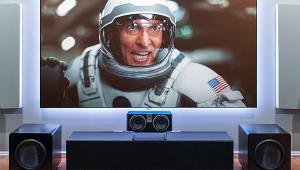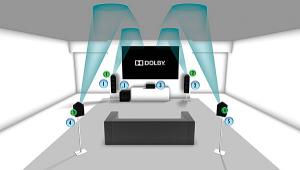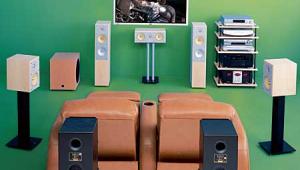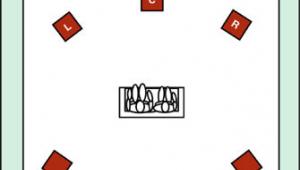HT Boot Camp: The Agony and the Ecstasy Page 2
Another deleterious effect from this placement is diffraction, which blurs the localization of the sound and makes the response uneven. Moving the face of the speaker forward so that it's flush with the edge of the display device minimizes this effect. Also, the speaker is often located higher than ear level in this situation and should be tilted down and aimed at the listening position. Double-check that the speaker is stable in this position. Many speakers are front-heavy and may require a tether or bracing to keep them from falling forward. It's best if the center speaker is no more than 2 to 3 feet above the main speakers in this situation. All in all, this placement is a reasonable compromise, the effects of which can be minimized with a bit of effort.

The next most common compromise is to hang the surround speakers on the side walls. There are many speakers on the market today that are specifically designed for this purpose and mitigate unwanted side effects. Once again, the boundary effect must be compensated for to avoid muddiness, so simply hanging general-purpose speakers on the wall is less than optimal. If your surround speakers are dipoles (sound is emitted from both the front and rear), such as all Lucasfilm THX Ultra- and some THX Select-certified surround speakers, they should be hung directly to the sides of (or slightly behind) the main listening area and 20 degrees above ear height. In most rooms, this works out to be 5 to 6 feet above the floor. In the case of monopole surrounds, they too should be mounted 5 to 6 feet above the floor, but they may be placed even farther toward the back of the room if necessary. Remember to keep them equidistant from the main listening position, unless your processor is equipped with individual delay adjustments for each channel. If you're using a THX-certified receiver or processor with Dolby Digital capability, it will have independent adjustable time delays on all channels, lessening the requirement that the speakers be equidistant.
If a cabinet or bookcase is used to contain the front speakers, things get a bit more complex. If at all possible, mount the left and right speakers at ear height on either side of your display device and place only the center speaker above or below it. Try to have the center speaker no more than 2 to 3 feet above or below the main speakers, however. Place the speakers as far forward in the cabinet as possible so that the baffle of each speaker is flush with the front of (and snugly fitted into) the cabinet. Avoid having a large gap between the face of the speaker and the face of the cabinet. You don't want to have sound bouncing around inside the cabinet. In the event that the speaker must sit on an open shelf, filling the shelf around the speaker with books helps to approximate a flush installation.
If a flush installation isn't possible, fill the area around the speaker with acoustically absorptive material. If the speakers are concealed with cloth panels, be certain to use sheer fabric. To test the fabric, hold it up to the light; you should be able to see through it. A more-conclusive test is to drape the fabric over one speaker while it's playing. Listen for a reduction in high frequencies when the cloth is in place. Choose a cloth that has minimal effect on the sound. The frame that supports the cloth should fit snugly around the face of the speaker and be flush with the edge of the speaker cabinet. A smooth fit will minimize diffraction. Consult the speaker's manufacturer as to whether the original grille should be left in place when mounted behind a cloth panel. While it may seem logical to remove the original grille to avoid passing the sound through a second layer of cloth, the grille's supporting frame may be integral to the proper operation of the speaker. Remember that the boundary effect applies here, as well, so engage boundary compensation, if available.



















































